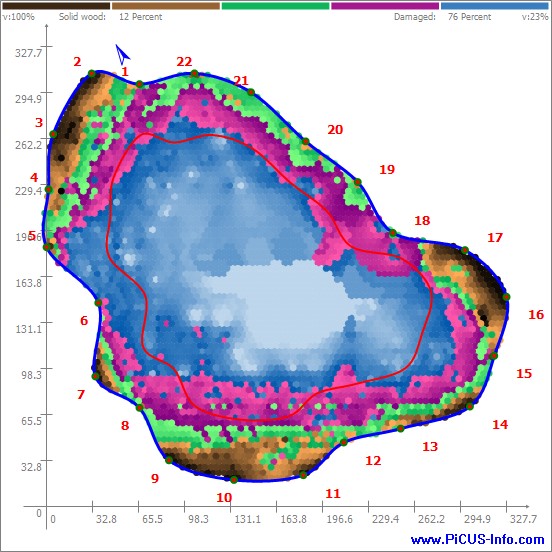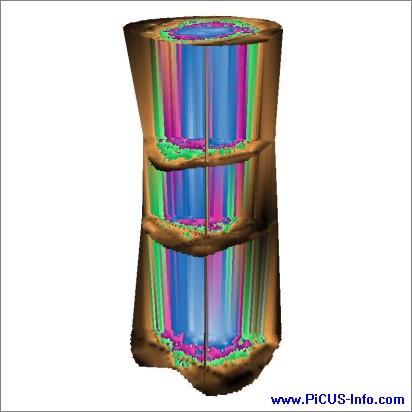
Sometimes it is necessary to look a little deeper in order to determine what is going on below the bark or within the rootzone. Recent advances in timber assessment technology allow the tooled-up arboriculturist to largely eliminate guesswork, and with confidence determine the internal structure of a tree. At Soundwood we operate a range of specialist kit to complement our arboricultural management and planning services. These include:
PiCUS Sonic Tomography represents a powerful tool in modern tree management. Consisting of an array of sensors/receivers connected to the tree by small nails inserted into the bark, the PiCUS tomograph records the time of flight of sound waves, propagated by tapping an activated sensor, between each of the other sensor/receivers. Our consultants have been using this technology to determine the presence and extent of wood decay and structural defects in trees since shortly after its introduction, and have been at the forefront of its application in UK tree management.


To ensure the greatest possible accuracy, the PiCUS tomograph and PiCUS callipers are operated by knowledgeable and experienced consultants, who analyse data as it is collected using the latest professional software. Tomograms can be taken at any height above ground level, from the lowest practical point up to 6m.
We can detect decay or defects in trees with a maximum circumference of 10m at the measuring level using up to 24 sensors. Additionally, a series of tomograms taken laterally at various points on the tree can be stacked in ascending order to give vertical 3D representations of its internal condition [please see example above right]
SoundWood offer a comprehensive range of service levels and reports for the PiCUS from execution only through to detailed tree assessments.
The Resistograph measures the resistance and changes in torque to a probe with a sharp flattened tip 3.0mm wide, rotating at a consent speed and driven into wooden objects such as utility poles, structural timbers and trees. The device is extremely sensitive and records information relating to the strength of the examined timber onto a wax paper along the length of the drilling path. The greater the resistance, the higher the tracing recorded.
The resistance to penetration may vary between tree species and also between trees of the same species. It may also vary in different parts of a tree and can be dependent on factors such as the pattern of growth and the presence of resins, reaction wood, and harmless bacterial wet wood. It may also be affected by the variations in wood density such as occur between functional sapwood, heartwood and tree reaction zones to fungal invasion.
It gives good identification of dangerous brittle wood, as found in brown rot and advanced soft rot, which are depicted as a steep drop in the tracing. However, certain types of rot, such as the early stages of white rot, may present a higher reading - but with a smoothing of the differences between late and early wood. Only at an advanced stage will these rots record significant reductions on the tracings. As such, the data recorded needs careful and experienced interpretation.
PiCUS Sonic Tomograph Dorset
Dorset Tree Consultants 2023